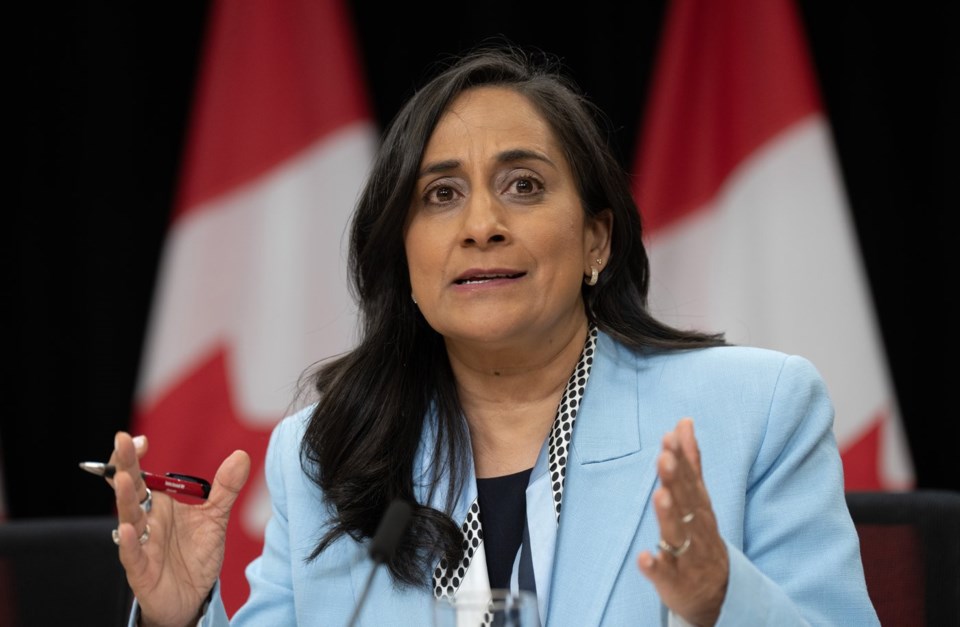OTTAWA — Her kids are not reading the newspapers on her kitchen counter. Instead, they're looking at their phones to find information.
That's the example that Treasury Board President Anita Anand brings up when she's asked about the federal government's efforts to get its message out via payments to social-media influencers.
She says it worries her that actors who seek to spread disinformation can more easily do that on the platforms where members of the younger generation, including her own kids, spend their time.
Since 2021, federal government departments and agencies have spent at least $1.7 million on influencers, and influencer marketing campaigns and strategies, documents recently tabled in the House of Commons and publicly available contracts show.
It's just a fraction of what the government otherwise spends on traditional advertising.
"We need to evolve with the times," Anand, who holds the government's purse strings, said at a recent press conference.
Most of the social-media money is going towards institutions that have public service announcements to put out about health, travel or other topics that are also fodder for newspaper ads or commercials on TV and radio.
Health Canada, Public Health Agency of Canada, Agriculture and Agri-Food Canada and Immigration, Refugees and Citizenship Canada are all tapping influencers, or people on social-media who have built large audiences and sometimes have a reputation for expertise on certain topics.
Not all departments disclosed their data in the recently published documents, citing a constraint on time.
Recent campaigns include ones focused on promoting the COVID-19 vaccine and food safety.
These are topics ripe for disinformation, argued Anand.
"We are now in an era where people debate what is true," she said.
"And in order to be in the realm of discussing the truth, we need to ensure that the work that we are doing in whatever portfolio is actually disseminated in an honest and clear way so that Canadians can understand what their taxpayer dollars are paying for."
Health Minister Mark Holland echoed the comments and invoked fears over foreign interference, saying governments such as Russia's are using modern technologies to destabilize democracies by questioning "what is and isn't true."
He oversees the federal bodies that are shelling out the most for influencers, with Health Canada and the Public Health Agency of Canada spending more than $1.3 million combined.
Influencers have been hired to put out government-approved messaging on topics such as safe cannabis use, dementia prevention, sexual health and mental-health resources.
"If we're not using alternative methods of communicating, then we're going to be failing to connect people to those services and they're rightfully going to be upset that they didn't get the opportunity to avail themselves," Holland said.
As the government turns to influencers for marketing, that doesn't mean it's leaving traditional media behind.
For example, Health Canada spent a total of $641,878 on contracts with digital marketing firms between 2021-22 and 2023-24, just 2.5 per cent of the total $25.7 million that was spent on all of Health Canada's marketing and advertising campaigns over the same time period.
The paid influencers are on a variety of platforms, including Instagram, YouTube and Facebook.
They're also on TikTok, which was banned from government devices because of its potential national security risk and is under federal review.
The popular video app still remains an important platform for Ottawa to connect with Canadians, including millennials and Gen Z, whom the Liberals are trying to court ahead of the next federal election.
"We know that influencers are able to reach different sectors of the Canadian population through different media platforms," Anand said.
"That doesn't mean the decision relating to TikTok is somehow wrong. It just means that we need to be using safe platforms in order to disseminate the information about our policy and reach those particular sectors of the population."
Other departments have also used unpaid influencers to help promote the government's messaging by inviting them to some of their press conferences alongside traditional print and broadcast journalists.
That includes deputy prime minister Chrystia Freeland, who invited unpaid influencers to the launch of this year's federal budget. Last year, similar outreach took place, with YouTube itself playing a part in facilitating the connections.
"A lot of Canadians get their information from other sources," Freeland said alongside her cabinet colleagues.
"And it's our responsibility to be sure that we are meeting Canadians where they are."
This report by The Canadian Press was first published June 25, 2024.
Mickey Djuric, The Canadian Press



